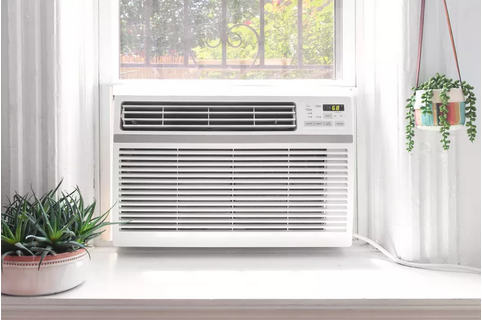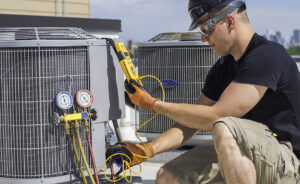As warmer weather rolls into town and you’re using your window air conditioner more and more, you may be surprised someday to see ice forming on the outside of the unit. This may seem counterintuitive. Air conditioners are supposed to cool the inside of your house. So why does the outside look like an old frosted-up freezer?
You might think this is a sign of a faulty air conditioner that needs to be replaced, but that’s only rarely true. While it is possible such an air conditioner needs repair, it’s equally likely that some simple maintenance will correct the issue. It’s even possible you simply need to adjust the controls on the appliance.
How an Air Conditioner Works
To understand why a window air conditioner might freeze up, it helps to understand the physics by which it cools the air. All air conditioners work through the principle that a gas (the refrigerant) cools down as it expands and grows hotter as it is condensed. It is the same principle that causes a bicycle tire to grow warm to the touch when you pump it full of air or a can of compressed whipped cream to grow cold to the touch as you empty it.
An air conditioner works with a closed loop of coils filled with refrigerant gas that first is expanded to cool down so it can absorb indoor heat. Then, it’s pumped outdoors and compressed so that its heat is radiated outdoors. This circular movement of refrigerant from expansion (cooling) coils to condensing (radiating) coils continues constantly while the appliance is running.
To operate correctly, the AC unit depends on the reliable circulation of air to carry off the condensed moisture from the coils. Problems with the flow of air or with the flow of refrigerant through the coils can cause moisture to freeze and ice to form on the coils.
Here are seven common reasons why a window air conditioner might freeze up during operation.
Airflow Is Poor
Your air conditioner depends on the free flow of air past the coils to properly work, and if dust, debris, or other obstacles build up on the coils themselves, the chilled refrigerant in the coils can’t properly absorb heat from the room and instead may absorb it from moisture on the coils, causing it to freeze.
The solution to blocked coils is usually nothing more complicated than a good cleaning. This requires removing the window air conditioner unit from the window, taking off the front cover, and removing the outer metal jacket to access the interior parts that need to be cleaned. Bring the unit outdoors, and spray the front and rear coils with an air conditioner coil cleaner, following the manufacturer’s directions. Rinse the coils with a hose, if necessary (some cleaners are “self-rinsing,” but make sure the coils are clean before you skip the rinse). Wipe off the fan blades on the large fan at the rear of the unit. If the coil fins are badly bent, straighten them with a fin comb.
Similarly, airflow can be blocked if the air filter through which the air circulates gets clogged with dust, dirt, or debris such as pet hair. Be sure to clean the filter at the front of the unit. The filter helps keep the coils clean and should be checked and/or cleaned monthly during the cooling season.
Finally, airflow can be inhibited if furniture or draperies are positioned so they block the vents on the air conditioner. Make sure that air can flow freely in and out of your appliance.
Drain System Isn’t Working Correctly
The process by which the indoor evaporator coils absorb heat also causes moisture to condense onto the coils. The air conditioner has a catch pan and drainage tube that allow this moisture to drain away outside the house, but if this drain system gets clogged, excess moisture can gather on the coils and freeze up as the heat is extracted. If your air conditioner isn’t dripping a small amount water outside the home when it is running full blast, check to make sure the drainage tube isn’t blocked.
Thermostat and Fan Settings Are Incorrect
In some instances, setting the fan speed too low while the thermostat is set to a low temperature will prevent the air conditioner from properly transferring its heat from indoors to outdoors. This is sometimes done to minimize the noise of the appliance, but if the unit is working hard to lower the indoor temperature, it needs to run at a fairly high fan speed to circulate lots of air through the coils. Often, it’s enough just to turn up the fan speed to stop ice buildup.
The only time you should use a low fan setting is when the humidity outside is unusually high and the air conditioner is having a hard time keeping the room dry. Lower airflow through the system can help the unit dehumidify more effectively.
Similarly, you can try raising the thermostat a few degrees so the unit doesn’t have to circulate such ice-cold refrigerant. As a general rule, air conditioners are designed to cool most efficiently to about 68 degrees. They can go colder, but setting the temperature way down can cause the unit to freeze up.
Refrigerant Level Is Low
Another potential problem is that the air conditioner coils may have a slow leak, causing the appliance to be low on refrigerant. This causes low flow within the unit, and although the unit does continue to cool, it doesn’t do so very efficiently. Because there is less refrigerant in the system, it must expand considerably more as it transitions from liquid to gas, and more expansion translates into a lower temperature that can very quickly freeze any moisture.
The refrigerant used on older air conditioners was Freon (which is bad for the ozone layer), but newer models use more environmentally friendly refrigerants. Still, the U.S. Environmental Protection Agency now prohibits “topping up” of refrigerant yourself, as was done in the old days. Low refrigerant indicates a leak, and the organization requires that leaks be found and fixed by a certified technician before the unit can be recharged with refrigerant.
Air Conditioner Is Oversized
Ice buildup can occur if a window air conditioner is too large for the room it serves. An oversized AC often short-cycles, turning on and off frequently. This prevents the good air circulation that normally keeps moist air from condensing on the cooling coils and freezing up.
Outdoor Temperature Is Too Low
Air conditioners aren’t meant to run when outdoor air is below roughly 62 degrees. Running the AC when the outside temperatures are too low can cause the refrigerant to get so cold that it freezes the moisture in room air before it can even circulate through the coils. If you’re seeking to cool off the house when outdoor temperatures are mild, it’s sometimes best to open windows rather than run the AC.
Problems With the Compressor
An inefficient compressor that doesn’t pump the refrigerant properly may not cool the coils enough to shut off the cold control on the appliance. Instead, the temperature may linger just above the level that would cause the AC to automatically shut off. Because the coil stays continually cool, condensed moisture eventually begins an ice buildup.
Unfortunately, a bad compressor isn’t usually fixable and will need to be replaced. With window ACs, it is often more practical to replace the entire unit rather than to invest in compressor repair or replacement.
Text taken from: https://www.thespruce.com/






